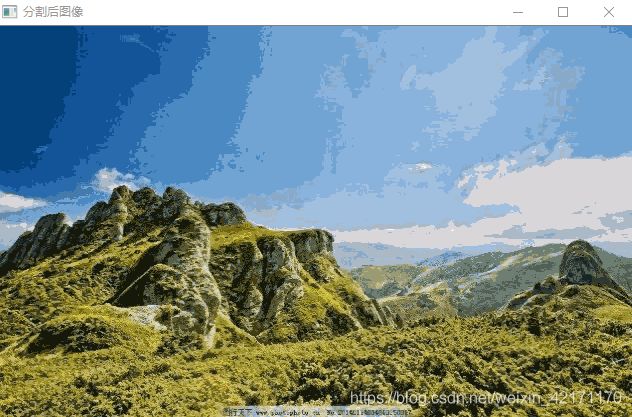- 深度学习目标检测中的_单目测距原理与实现 关键点及改进建议
QQ_767172261
单目测距深度学习目标检测人工智能
深度学习目标检测中的_单目测距原理与实现关键点及改进建议文章目录单目测距的进一步解释1.焦距的确定2.物体宽度\(W\)的获取3.图像处理技巧4.提高性能的建议5.实现代码中的注释添加一、前言单目视觉测距:网上有很多关于单目测距的文章,主要借鉴的是OpenCV学习笔记(二十一)——简单的单目视觉测距尝试和单目摄像机测距(python+opencv)两篇文章,在这里特别作出说明。工作环境:Ubunt
- opencv学习笔记19-opencv焊点(原点)计数
The_xz
opencv学习笔记
一、原理:opencv学习笔记13-opencv连通组件标记实现硬币计数二、不同情况思路:当焊点为背景时,进行反色处理(二值化后若焊点为背景,转化为前景)。三、示例代码:#include#include#include#include#include#includeusingnamespacecv;usingnamespacestd;intmain(){utils::logging::setLog
- OpenCV学习笔记:如何扫描图像、利用查找表和计时
weixin_33772645
人工智能c/c++测试
目的我们将探索以下问题的答案:如何遍历图像中的每一个像素?OpenCV的矩阵值是如何存储的?如何测试我们所实现算法的性能?查找表是什么?为什么要用它?测试用例这里我们测试的,是一种简单的颜色缩减方法。如果矩阵元素存储的是单通道像素,使用C或C++的无符号字符类型,那么像素可有256个不同值。但若是三通道图像,这种存储格式的颜色数就太多了(确切地说,有一千六百多万种)。用如此之多的颜色可能会对我们的
- Opencv学习笔记——特征匹配
纸箱里的猫咪
Opencv学习笔记opencv计算机视觉学习
文章目录Brute-Force蛮力匹配1对1的匹配k对最佳匹配随机抽样一致算法(Randomsampleconsensus,RANSAC)单应性矩阵Brute-Force蛮力匹配 通过SIFT算法可以得到图像关键点,通过比较两张图像的关键点,也就是比较关键点向量之间的差异,Brute-Force蛮力匹配通过比较特征向量,离得最近的特征向量也就是最相似的。默认的是用归一化的欧氏距离。bf=cv2.
- OpenCV学习笔记(Python)—— 批量提取图像轮廓并保存结果到保持原始结构的输出目录
六个核桃Lu
OpenCV学习opencv人工智能python图像处理计算机视觉
批量处理图像,对每个图像提取轮廓内的区域并将轮廓外的区域设置为白色背景,然后保存处理后的图像到指定的输出目录,同时保持与输入目录相同的文件和目录结构。importcv2importnumpyasnpimportosfromtqdmimporttqdmdefprocess_image(input_path,output_path):#读取图像img=cv2.imread(input_path)ifi
- OpenCV学习笔记2——视频的读取与处理
风痕天际
opencv学习笔记opencv学习笔记计算机视觉音视频
目录一、视频内容读取二、将视频中的每一帧转换为灰度图三、退出程序一、视频内容读取cv2中的“VideoCapture”函数可以捕获摄像头,用数字来控制不同的设备,如果是视频文件则直接指定路径。importcv2vc=cv2.VideoCapture('1.mp4')whileTrue:ret,frame=vc.read()ifframeisNone:breakifret==True:gray=cv
- OpenCV学习笔记4——边界填充
风痕天际
opencv学习笔记opencv学习笔记
边界填充,即将图片扩大一圈。代码如下:importcv2frommatplotlibimportpyplotaspltimg=cv2.imread('3.jpg')top_size,bottom_size,left_size,right_size=(50,50,50,50)replicate=cv2.copyMakeBorder(img,top_size,bottom_size,left_size
- OpenCV学习笔记1——图像读取与信息提取
风痕天际
opencv学习笔记opencvpython计算机视觉
目录一、计算机眼中的图像二、通过代码对图像进行操作1.图像的读取2.图像的显示三、将图像读取为灰度图像四、保存图像一、计算机眼中的图像在计算机中,图像被视为一个高度×宽度的像素矩阵,每一个矩阵内存放着该像素的色彩信息。计算机中大多采用RGB颜色标准,即通过对红(R)、绿(G)、蓝(B)三个颜色通道的变化以及它们相互之间的叠加来得到各式各样的颜色。部分颜色对应RGB值:白色:rgb(255,255,
- OpenCV学习笔记:矩阵的掩码操作
weixin_34292287
人工智能测试c/c++
矩阵的掩码操作很简单。其思想是:根据掩码矩阵(也称作核)重新计算图像中每个像素的值。掩码矩阵中的值表示近邻像素值(包括该像素自身的值)对新像素值有多大影响。从数学观点看,我们用自己设置的权值,对像素邻域内的值做了个加权平均。测试用例思考一下图像对比度增强的问题。我们可以对图像的每个像素应用下面的公式:上面那种表达法是公式的形式,而下面那种是以掩码矩阵表示的紧凑形式。使用掩码矩阵的时候,我们先把矩阵
- C++&OpenCV学习笔记(0):从开始到放弃
打工人 老王
c++opencv学习
文章目录前言环境配置HelloworldC++和C#语法对比模板字符串list列表总结前言作为一个计算机本科学生,我大学的时候深深的被指针和内存管理给折磨过。我深刻的理解内存泄漏的巨大问题。但是我最近学习Python的时候发现,Python是真的不好进行项目管理,而且性能很差。我还看到了网上说,C#其实可以白嫖OpenCV。这个世界上有没有编程语言既有Python的开发效率,又有C/C++/Rus
- 【OpenCV学习笔记10】- 【彩蛋】使用cv.addWeighted()函数利用多张图片实现平滑过渡的幻灯片效果
夜七天
PythonOpenCVopencv学习笔记人工智能python计算机视觉
这是对于OpenCV官方文档的核心操作的学习笔记。学习笔记中会记录官方给出的例子,也会给出自己根据官方的例子完成的更改代码,同样彩蛋的实现也会结合多个知识点一起实现一些小功能,来帮助我们对学会的知识点进行结合应用。如果有喜欢我笔记的请麻烦帮我关注、点赞、评论。谢谢诸位。学习笔记:学习笔记目录里面会收录我关于OpenCV系列学习笔记博文,大家如果有什么不懂的可以通过阅读我的学习笔记进行学习。【Ope
- 【OpenCV学习笔记08】- 图像基本操作
夜七天
OpenCVPythonopencv学习笔记计算机视觉python人工智能
关于OpenCV官方文档的GUI功能告一段落,接下来开始核心操作的学习。学习笔记中会记录官方给出的例子,也会给出自己根据官方的例子完成的更改代码,同样彩蛋的实现也会结合多个知识点一起实现一些小功能,来帮助我们对学会的知识点进行结合应用。如果有喜欢我笔记的请麻烦帮我关注、点赞、评论。谢谢诸位。学习笔记:学习笔记目录里面会收录我关于OpenCV系列学习笔记博文,大家如果有什么不懂的可以通过阅读我的学习
- 【OpenCV学习笔记09】- 图像的算术运算
夜七天
OpenCVPythonopencv学习笔记计算机视觉python人工智能
这是对于OpenCV官方文档的核心操作的学习笔记。学习笔记中会记录官方给出的例子,也会给出自己根据官方的例子完成的更改代码,同样彩蛋的实现也会结合多个知识点一起实现一些小功能,来帮助我们对学会的知识点进行结合应用。如果有喜欢我笔记的请麻烦帮我关注、点赞、评论。谢谢诸位。学习笔记:学习笔记目录里面会收录我关于OpenCV系列学习笔记博文,大家如果有什么不懂的可以通过阅读我的学习笔记进行学习。【Ope
- 【OpenCV学习笔记】- 学习笔记目录
夜七天
PythonOpenCVopencv学习笔记python计算机视觉人工智能
本篇博文是我对于OpenCV初识、第一次使用、基础学习、深入学习的笔记目录,方便我对OpenCV系列博文的管理,也方便大家查阅。OpenCV学习笔记目录OpenCV简介:【OpenCV学习笔记01】-初识OpenCVOpenCV初次使用:【OpenCV学习笔记01】-初步使用OpenCV实现人脸识别OpenCVGUI功能:【OpenCV学习笔记02】-图像入门【OpenCV学习笔记03】-视频入门
- 【OpenCV学习笔记11】- 性能测量和改进技术
夜七天
OpenCVPythonopencv学习笔记python计算机视觉人工智能
这是对于OpenCV官方文档的核心操作的学习笔记。学习笔记中会记录官方给出的例子,也会给出自己根据官方的例子完成的更改代码,同样彩蛋的实现也会结合多个知识点一起实现一些小功能,来帮助我们对学会的知识点进行结合应用。如果有喜欢我笔记的请麻烦帮我关注、点赞、评论。谢谢诸位。学习笔记:学习笔记目录里面会收录我关于OpenCV系列学习笔记博文,大家如果有什么不懂的可以通过阅读我的学习笔记进行学习。【Ope
- 【OpenCV学习笔记06】- 制作使用轨迹条控制的调色板
夜七天
OpenCVPythonopencv学习笔记人工智能python计算机视觉
内容学习将轨迹栏绑定到OpenCV窗口。你将学习这些函数:cv.getTrackbarPos(),cv.createTrackbar()等等。调色板代码这里,我们将创建用以显示指定颜色的简单程序。你有一个显示颜色的窗口和三个轨迹栏,用来指定B,G,R颜色。你可以滑动轨迹栏改变窗口的颜色。默认情况下,初始颜色为黑色。对于cv.createTrackbar()函数,第一个参数是轨迹栏名字,第二个参数是
- 【OpenCV学习笔记07】- 【彩蛋】实现轨迹条控制画笔颜色和笔刷半径,并可以正常绘画
夜七天
PythonOpenCVopencv学习笔记python计算机视觉人工智能
彩蛋实现轨迹条控制画笔颜色和笔刷半径,并可以正常绘画。直接上彩蛋代码示例代码:#彩蛋,创建一个可以调节颜色和笔刷半径的轨迹栏,并且可以通过鼠标进行绘画importnumpyasnpimportcv2ascv#定义全局变量#如果True是鼠标按下drawing=True#如果True,画矩形,按下‘m’切换到曲线mode=True#笔刷半径,默认是1radius_of_brush=1#笔刷颜色b,g
- 【OpenCV学习笔记05】- 鼠标作为画笔
夜七天
PythonOpenCVopencv学习笔记计算机视觉python
内容学习如何用OpenCV处理鼠标事件您将学习以下功能:cv.setMouseCallback()简单的示例这里,我们创建一个简单的程序,在图像的任何位置双击在上面画一个圆。首先我们创建一个鼠标回调函数,该函数在鼠标事件发生时执行。鼠标事件可以是与鼠标有关的任何内容,比如鼠标左键按下,左键弹起,左键双击等等。所有鼠标事件都给我们提供坐标(x,y)。通过这个事件和位置,我们能做任何我们喜欢的事情。要
- 【OpenCV学习笔记04】- 绘图功能
夜七天
PythonOpenCVopencv学习笔记计算机视觉python
内容用OpenCV画不同的几何图形学习这些函数:cv.line(),cv.circle(),cv.rectangle(),cv.ellipse(),cv.putText()等。函数常用传参在上述所有功能中,您将看到一些常见的参数,如下所示:img:您要绘制形状的图像对象;color:形状的颜色,如BGR,它是一个元组,例如:蓝色(255,0,0)。对于灰度图,只需传一个标量值。thickness:
- 【OpenCV学习笔记03】- 视频入门
夜七天
PythonOpenCVopencv学习笔记python计算机视觉
内容学习加载视频、显示视频和保存视频。学习用相机捕捉并显示。你要学习这些函数:cv.VideoCapture(),cv.VideoWriter()从相机捕捉视频通常情况下,我们必须用摄像机捕捉实时画面。提供了一个非常简单的界面。让我们从摄像头捕捉一段视频(我使用的是我笔记本电脑内置的网络摄像头),将其转换成灰度视频并显示出来。只是一个简单的任务开始。要捕获视频,你需要创建一个VideoCaptur
- 【OpenCV学习笔记02】- 图像入门
夜七天
OpenCVPythonopencv学习笔记python
内容这里介绍了图像处理的入门操作,,你将学习如何读取图像,如何显示图像以及如何将其保存回去你将学习以下功能:cv.imread(),cv.imshow(),cv.imwrite()简单使用OpenCV读取图像使用cv.imread()函数读取图像。图像应该在工作目录或图像的完整路径应给出。第二个参数是一个标志,它指定了读取图像的方式。cv.IMREAD_COLOR:加载彩色图像。任何图像的透明度都
- Opencv学习笔记(三):图像二值化函数cv2.threshold函数详解
ZZY_dl
#Opencvopencv计算机视觉python
文章目录1何为图像的二值化2常见的阈值类型3函数介绍4代码实例5运行结果1何为图像的二值化图像二值化函数cv2.threshold函数的介绍。图像的二值化,就是将图像上的像素点的灰度值设置为0或255,也就是将整个图像呈现出明显的只有黑和白的视觉效果(灰度值0:黑,灰度值255:白).在图像中除了目标物体和背景区域,还有噪声,这都会对于我们对图像的识别造成困扰,所以我们要通过图像二值化函数将多值的
- Opencv学习笔记(二)图像基本操作
code2035
OpenCV从入门到精通opencv学习笔记
图像基本操作一、边界填充二、图像融合三、图像阈值四、图像平滑五、形态学预算1、腐蚀操作2、膨胀操作3、开闭运算操作4、梯度运算5、顶帽运算6、黑帽运算一、边界填充cv2.copyMakeBorder(img,top_size,bottom_size,left_size,right_size,borderType=?)(1)cv2.BORDER_REPLICATE,复制法,赋值最边缘像素(2)cv2
- OpenCV学习笔记----显示图像
嵌入式-小王
OpenCVopencvlinuxc++
第一个程序:显示图片一个简单加载图像并显示的程序#includeusingnamespacecv;intmain(){Matimg=imread("/home/wang/opencv/demo/1.jpg");if(img.empty()){return-1;}namedWindow("Example1",cv::WINDOW_AUTOSIZE);imshow("Example1",img);wa
- OpenCV学习笔记 - 使用 OpenCV 检测运动的最简单方法
坐望云起
OpenCV从入门到精通深度学习从入门到精通数字图像处理从入门到精通opencv计算机视觉运动检测帧差分光流算法背景扣除
一、运动检测运动检测是检测视频序列中移动对象的过程。在计算机视觉中,它是检测视频帧中像素级变化的过程。我们可以用它来发现现实世界中的新对象,甚至执行与类无关的对象检测,这在地理空间分析、客户分析、监视、自治和其他相关领域非常有用。如何检测视频中的运动?这里介绍了一些可用于检测运动的基本方法,并展示了如何使用Python从头开始编写每种方法。主要技术如下第1部分—帧差分第2部分—光流第3部分—背景扣
- opencv学习笔记六十九:人脸识别综合实践
东城青年
opencv实时人脸识别人脸识别综合实践
1、下载人脸数据集,典型的有ORL,yale,我这里下载的是ORL人脸数据集,下载网址https://www.cl.cam.ac.uk/research/dtg/attarchive/facedatabase.html。2、将所有图片的路径保存在一个txt文件中,方便后面读取所有图片。//ifstream主要对文件读操作//ofstream主要对文件进行读写#includeofstreamfile
- OpenCV学习笔记(1):仿射getAffineTransform和warpAffine
RyanL007
OpenCV
由于工作原因,最近开始研究图像处理相关技术,开始接触OpenCV,主要是为了重构PACS系统中的平移、缩放和旋转三个图像操作的接口函数。opencv作为目前计算机视觉领域的热门开源库,有着稳定且功能强大的优点。下面是刚接触时的一些研究,主要是学习仿射,及一些相关的函数接口的使用,这里整理一下,方便以后查看,若有错误的地方还请谅解,随意评论纠正!看到很多代码示例都有cv::Mat的字眼,cv是ope
- OpenCV入门(四)—— 窗口及滑动条操作
不乏希望
Opencv基础操作OpenCVubuntucmake
OpenCV学习笔记1.destroyWindow("[str]");移除并销毁名为str的窗口。2.destroyAllWindows();移除并销毁所有窗口。3.moveWindow("[str]",x,y);将名为str的窗口移动到距离桌面左侧x像素距离、距桌面顶部y像素距离的位置上。4.displayOverlay("[str1]","[str2]",time);在图像str1的区域的顶部
- Qt-OpenCV学习笔记--图像的腐蚀--erode()
搞机械的假程序猿
opencv学习计算机视觉qt
概述通过一个特定的结构元素腐蚀一个图像。图像腐蚀的过程类似于一个卷积的过程,源图像矩阵A以及结构元素B,B在A矩阵上依次移动,每个位置上B所覆盖元素的最小值替换B的中心位置值(即锚点处),完成整个腐蚀的过程。算法通俗理解:其运算过程就是使用用3X3的结构元素,扫描二值图像的每一个像素,用结构元素与其覆盖的二值图像做“与”运算,如果都为1,结构图像的该像素为1,否则为0。结果就是使二值图像减小一圈。
- c++ opencv mat_OpenCV学习笔记(1)
weixin_39775976
c++opencvmatc++opencv实现区域填充c++opencv求mat的最小值c++opencv实现区域填充opencvimshow不显示图像opencvmat类
由于我所在的实验室主要是研究无人机智能巡检,因此大多数的项目涉及到图像识别。说到图像识别自然少不了著名的图像处理库OpenCV。因此想趁着这个史无前例的长假期,好好学习一下OpenCV。首先说一下我的开发环境,操作系统ManjaroLinux,开发语言C++,IDECLion,编译器gcc9.2.0,OpenCV版本4.2,cmake。至于为什么使用ManjaroLinux而不是用大家经常使用Ub
- java工厂模式
3213213333332132
java抽象工厂
工厂模式有
1、工厂方法
2、抽象工厂方法。
下面我的实现是抽象工厂方法,
给所有具体的产品类定一个通用的接口。
package 工厂模式;
/**
* 航天飞行接口
*
* @Description
* @author FuJianyong
* 2015-7-14下午02:42:05
*/
public interface SpaceF
- nginx频率限制+python测试
ronin47
nginx 频率 python
部分内容参考:http://www.abc3210.com/2013/web_04/82.shtml
首先说一下遇到这个问题是因为网站被攻击,阿里云报警,想到要限制一下访问频率,而不是限制ip(限制ip的方案稍后给出)。nginx连接资源被吃空返回状态码是502,添加本方案限制后返回599,与正常状态码区别开。步骤如下:
- java线程和线程池的使用
dyy_gusi
ThreadPoolthreadRunnabletimer
java线程和线程池
一、创建多线程的方式
java多线程很常见,如何使用多线程,如何创建线程,java中有两种方式,第一种是让自己的类实现Runnable接口,第二种是让自己的类继承Thread类。其实Thread类自己也是实现了Runnable接口。具体使用实例如下:
1、通过实现Runnable接口方式 1 2
- Linux
171815164
linux
ubuntu kernel
http://kernel.ubuntu.com/~kernel-ppa/mainline/v4.1.2-unstable/
安卓sdk代理
mirrors.neusoft.edu.cn 80
输入法和jdk
sudo apt-get install fcitx
su
- Tomcat JDBC Connection Pool
g21121
Connection
Tomcat7 抛弃了以往的DBCP 采用了新的Tomcat Jdbc Pool 作为数据库连接组件,事实上DBCP已经被Hibernate 所抛弃,因为他存在很多问题,诸如:更新缓慢,bug较多,编译问题,代码复杂等等。
Tomcat Jdbc P
- 敲代码的一点想法
永夜-极光
java随笔感想
入门学习java编程已经半年了,一路敲代码下来,现在也才1w+行代码量,也就菜鸟水准吧,但是在整个学习过程中,我一直在想,为什么很多培训老师,网上的文章都是要我们背一些代码?比如学习Arraylist的时候,教师就让我们先参考源代码写一遍,然
- jvm指令集
程序员是怎么炼成的
jvm 指令集
转自:http://blog.csdn.net/hudashi/article/details/7062675#comments
将值推送至栈顶时 const ldc push load指令
const系列
该系列命令主要负责把简单的数值类型送到栈顶。(从常量池或者局部变量push到栈顶时均使用)
0x02 &nbs
- Oracle字符集的查看查询和Oracle字符集的设置修改
aijuans
oracle
本文主要讨论以下几个部分:如何查看查询oracle字符集、 修改设置字符集以及常见的oracle utf8字符集和oracle exp 字符集问题。
一、什么是Oracle字符集
Oracle字符集是一个字节数据的解释的符号集合,有大小之分,有相互的包容关系。ORACLE 支持国家语言的体系结构允许你使用本地化语言来存储,处理,检索数据。它使数据库工具,错误消息,排序次序,日期,时间,货
- png在Ie6下透明度处理方法
antonyup_2006
css浏览器FirebugIE
由于之前到深圳现场支撑上线,当时为了解决个控件下载,我机器上的IE8老报个错,不得以把ie8卸载掉,换个Ie6,问题解决了,今天出差回来,用ie6登入另一个正在开发的系统,遇到了Png图片的问题,当然升级到ie8(ie8自带的开发人员工具调试前端页面JS之类的还是比较方便的,和FireBug一样,呵呵),这个问题就解决了,但稍微做了下这个问题的处理。
我们知道PNG是图像文件存储格式,查询资
- 表查询常用命令高级查询方法(二)
百合不是茶
oracle分页查询分组查询联合查询
----------------------------------------------------分组查询 group by having --平均工资和最高工资 select avg(sal)平均工资,max(sal) from emp ; --每个部门的平均工资和最高工资
- uploadify3.1版本参数使用详解
bijian1013
JavaScriptuploadify3.1
使用:
绑定的界面元素<input id='gallery'type='file'/>$("#gallery").uploadify({设置参数,参数如下});
设置的属性:
id: jQuery(this).attr('id'),//绑定的input的ID
langFile: 'http://ww
- 精通Oracle10编程SQL(17)使用ORACLE系统包
bijian1013
oracle数据库plsql
/*
*使用ORACLE系统包
*/
--1.DBMS_OUTPUT
--ENABLE:用于激活过程PUT,PUT_LINE,NEW_LINE,GET_LINE和GET_LINES的调用
--语法:DBMS_OUTPUT.enable(buffer_size in integer default 20000);
--DISABLE:用于禁止对过程PUT,PUT_LINE,NEW
- 【JVM一】JVM垃圾回收日志
bit1129
垃圾回收
将JVM垃圾回收的日志记录下来,对于分析垃圾回收的运行状态,进而调整内存分配(年轻代,老年代,永久代的内存分配)等是很有意义的。JVM与垃圾回收日志相关的参数包括:
-XX:+PrintGC
-XX:+PrintGCDetails
-XX:+PrintGCTimeStamps
-XX:+PrintGCDateStamps
-Xloggc
-XX:+PrintGC
通
- Toast使用
白糖_
toast
Android中的Toast是一种简易的消息提示框,toast提示框不能被用户点击,toast会根据用户设置的显示时间后自动消失。
创建Toast
两个方法创建Toast
makeText(Context context, int resId, int duration)
参数:context是toast显示在
- angular.identity
boyitech
AngularJSAngularJS API
angular.identiy 描述: 返回它第一参数的函数. 此函数多用于函数是编程. 使用方法: angular.identity(value); 参数详解: Param Type Details value
*
to be returned. 返回值: 传入的value 实例代码:
<!DOCTYPE HTML>
- java-两整数相除,求循环节
bylijinnan
java
import java.util.ArrayList;
import java.util.List;
public class CircleDigitsInDivision {
/**
* 题目:求循环节,若整除则返回NULL,否则返回char*指向循环节。先写思路。函数原型:char*get_circle_digits(unsigned k,unsigned j)
- Java 日期 周 年
Chen.H
javaC++cC#
/**
* java日期操作(月末、周末等的日期操作)
*
* @author
*
*/
public class DateUtil {
/** */
/**
* 取得某天相加(减)後的那一天
*
* @param date
* @param num
*
- [高考与专业]欢迎广大高中毕业生加入自动控制与计算机应用专业
comsci
计算机
不知道现在的高校还设置这个宽口径专业没有,自动控制与计算机应用专业,我就是这个专业毕业的,这个专业的课程非常多,既要学习自动控制方面的课程,也要学习计算机专业的课程,对数学也要求比较高.....如果有这个专业,欢迎大家报考...毕业出来之后,就业的途径非常广.....
以后
- 分层查询(Hierarchical Queries)
daizj
oracle递归查询层次查询
Hierarchical Queries
If a table contains hierarchical data, then you can select rows in a hierarchical order using the hierarchical query clause:
hierarchical_query_clause::=
start with condi
- 数据迁移
daysinsun
数据迁移
最近公司在重构一个医疗系统,原来的系统是两个.Net系统,现需要重构到java中。数据库分别为SQL Server和Mysql,现需要将数据库统一为Hana数据库,发现了几个问题,但最后通过努力都解决了。
1、原本通过Hana的数据迁移工具把数据是可以迁移过去的,在MySQl里面的字段为TEXT类型的到Hana里面就存储不了了,最后不得不更改为clob。
2、在数据插入的时候有些字段特别长
- C语言学习二进制的表示示例
dcj3sjt126com
cbasic
进制的表示示例
# include <stdio.h>
int main(void)
{
int i = 0x32C;
printf("i = %d\n", i);
/*
printf的用法
%d表示以十进制输出
%x或%X表示以十六进制的输出
%o表示以八进制输出
*/
return 0;
}
- NsTimer 和 UITableViewCell 之间的控制
dcj3sjt126com
ios
情况是这样的:
一个UITableView, 每个Cell的内容是我自定义的 viewA viewA上面有很多的动画, 我需要添加NSTimer来做动画, 由于TableView的复用机制, 我添加的动画会不断开启, 没有停止, 动画会执行越来越多.
解决办法:
在配置cell的时候开始动画, 然后在cell结束显示的时候停止动画
查找cell结束显示的代理
- MySql中case when then 的使用
fanxiaolong
casewhenthenend
select "主键", "项目编号", "项目名称","项目创建时间", "项目状态","部门名称","创建人"
union
(select
pp.id as "主键",
pp.project_number as &
- Ehcache(01)——简介、基本操作
234390216
cacheehcache简介CacheManagercrud
Ehcache简介
目录
1 CacheManager
1.1 构造方法构建
1.2 静态方法构建
2 Cache
2.1&
- 最容易懂的javascript闭包学习入门
jackyrong
JavaScript
http://www.ruanyifeng.com/blog/2009/08/learning_javascript_closures.html
闭包(closure)是Javascript语言的一个难点,也是它的特色,很多高级应用都要依靠闭包实现。
下面就是我的学习笔记,对于Javascript初学者应该是很有用的。
一、变量的作用域
要理解闭包,首先必须理解Javascript特殊
- 提升网站转化率的四步优化方案
php教程分享
数据结构PHP数据挖掘Google活动
网站开发完成后,我们在进行网站优化最关键的问题就是如何提高整体的转化率,这也是营销策略里最最重要的方面之一,并且也是网站综合运营实例的结果。文中分享了四大优化策略:调查、研究、优化、评估,这四大策略可以很好地帮助用户设计出高效的优化方案。
PHP开发的网站优化一个网站最关键和棘手的是,如何提高整体的转化率,这是任何营销策略里最重要的方面之一,而提升网站转化率是网站综合运营实力的结果。今天,我就分
- web开发里什么是HTML5的WebSocket?
naruto1990
Webhtml5浏览器socket
当前火起来的HTML5语言里面,很多学者们都还没有完全了解这语言的效果情况,我最喜欢的Web开发技术就是正迅速变得流行的 WebSocket API。WebSocket 提供了一个受欢迎的技术,以替代我们过去几年一直在用的Ajax技术。这个新的API提供了一个方法,从客户端使用简单的语法有效地推动消息到服务器。让我们看一看6个HTML5教程介绍里 的 WebSocket API:它可用于客户端、服
- Socket初步编程——简单实现群聊
Everyday都不同
socket网络编程初步认识
初次接触到socket网络编程,也参考了网络上众前辈的文章。尝试自己也写了一下,记录下过程吧:
服务端:(接收客户端消息并把它们打印出来)
public class SocketServer {
private List<Socket> socketList = new ArrayList<Socket>();
public s
- 面试:Hashtable与HashMap的区别(结合线程)
toknowme
昨天去了某钱公司面试,面试过程中被问道
Hashtable与HashMap的区别?当时就是回答了一点,Hashtable是线程安全的,HashMap是线程不安全的,说白了,就是Hashtable是的同步的,HashMap不是同步的,需要额外的处理一下。
今天就动手写了一个例子,直接看代码吧
package com.learn.lesson001;
import java
- MVC设计模式的总结
xp9802
设计模式mvc框架IOC
随着Web应用的商业逻辑包含逐渐复杂的公式分析计算、决策支持等,使客户机越
来越不堪重负,因此将系统的商业分离出来。单独形成一部分,这样三层结构产生了。
其中‘层’是逻辑上的划分。
三层体系结构是将整个系统划分为如图2.1所示的结构[3]
(1)表现层(Presentation layer):包含表示代码、用户交互GUI、数据验证。
该层用于向客户端用户提供GUI交互,它允许用户


